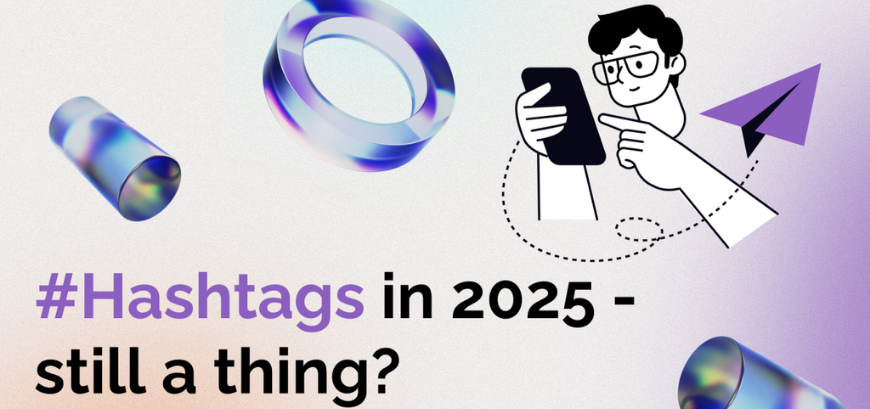The Changing Landscape of Hashtags
Remember the hashtag frenzy of 2015? Brands stuffed their Instagram posts with up to 30 hashtags, hoping for viral success. Fast forward to 2025, and the social media landscape has transformed dramatically. Hashtags are no longer about quantity—they’re about strategy.
With social media’s recent five-hashtag limit and evolving algorithms, marketers must rethink their approach. While some question whether hashtags still hold power, the truth is clear: when used strategically, they remain a vital tool for engagement and visibility.
What Is a Hashtag?
A hashtag is a word or phrase preceded by the ‘#’ symbol, used to categorize content on social media. When you include a hashtag in your post, it becomes discoverable to anyone searching for that topic. This increases reach and engagement, whether the hashtag is placed at the beginning, middle, or end of a post.
Key Hashtag Statistics in 2025
- Instagram posts with at least one hashtag see 12.6% more engagement than those without.
- The best-performing LinkedIn posts use 1-3 hashtags.
- Tweets with one or two hashtags receive 21% higher engagement, but those with more than two see a 17% drop.
These numbers highlight the importance of using hashtags strategically—not excessively.
Why Are Hashtags Still Important in 2025?
Despite algorithm changes, hashtags continue to play a crucial role in social media marketing. Here’s why:
1. Increased Visibility and Reach
Hashtags help users discover content even if they don’t follow you. For example, #TacoTuesday remains a popular weekly trend, connecting food bloggers, restaurants, and influencers. A well-chosen hashtag can expand your audience significantly.
2. Community Building and Engagement
Brands can foster online communities through hashtags. Coca-Cola’s #ShareACoke campaign encouraged users to share photos of personalized Coke bottles, boosting U.S. sales by over 2%. This strategy not only engaged fans but also generated valuable user-generated content.
3. Trends and Discoverability
Hashtags keep brands relevant by aligning with current trends. The #IceBucketChallenge, for instance, went viral and raised awareness for ALS. Additionally, hashtags function like mini-SEO tools, improving content discoverability on social platforms.
4. SEO Benefits
Beyond social media, hashtags enhance search rankings. Targeted hashtags help posts appear in both social searches and search engines, increasing visibility and engagement.
Challenges and Drawbacks of Hashtags in 2025
While hashtags offer numerous benefits, they also come with challenges:
1. Algorithm Limitations
Social media platforms are cracking down on hashtag abuse. Instagram now limits posts to five hashtags, and exceeding this can hurt performance. The focus is shifting toward quality over quantity.
2. Shadowbanning Risks
Using irrelevant or overused hashtags can lead to shadowbanning, where platforms hide content from followers without notice. Though platforms deny this practice, misuse of hashtags can reduce visibility.
3. Negative User Experience
Too many hashtags clutter posts, making them harder to read. Misleading hashtags can also frustrate users, leading to lower engagement and potential unfollows.
How to Choose the Right Hashtags in 2025
To maximize hashtag effectiveness, follow these best practices:
1. Analyze Successful Hashtags
Review past posts to identify which hashtags drove the most engagement. Repeating high-performing hashtags can improve future content.
2. Follow Trending Hashtags
Stay updated with trending hashtags in your industry. Tools like Twitter’s trending section can help you capitalize on viral topics.
3. Use Related Hashtags
Combine niche-specific hashtags with broader ones to reach both targeted and wider audiences.
4. Create Branded Hashtags
Develop unique hashtags for campaigns or branding. A memorable hashtag (like Nike’s #JustDoIt) strengthens brand identity and encourages user participation.
How Hashtags Perform on Different Platforms in 2025
- Optimal hashtag count: 5 (due to new limits).
- Best placement: In captions (89% of brands see better engagement).
- Character limit: Keep hashtags between 21-25 characters for effectiveness.
X (Formerly Twitter)
- Best practice: Use 1-2 hashtags per tweet (boosts engagement by 50%).
- Avoid: More than two hashtags (reduces engagement by 17%).
- Optimal hashtag count: 1 per post.
- Avoid: More than three hashtags (hurts performance).
- Best strategy: Use 1 niche hashtag + 2 general ones to reach professionals.
Conclusion: The Future of Hashtags in Social Media Marketing
Hashtags remain a powerful tool in 2025, but their usage has evolved. A well-planned strategy—focusing on relevance, trends, and platform-specific rules—can boost engagement and visibility.
As social media continues to change, brands must adapt. If navigating these updates feels overwhelming, partnering with a social media marketing agency can help craft a winning hashtag strategy.
Why Choose Altis Infonet?
With over two decades of experience, Altis Infonet helps brands thrive digitally. Their expert team optimizes social media presence across Facebook, Twitter, LinkedIn, and more, ensuring maximum engagement and lead generation.
In 2025 and beyond, hashtags will remain essential—but only for those who use them wisely. Stay strategic, stay relevant, and watch your brand grow!





